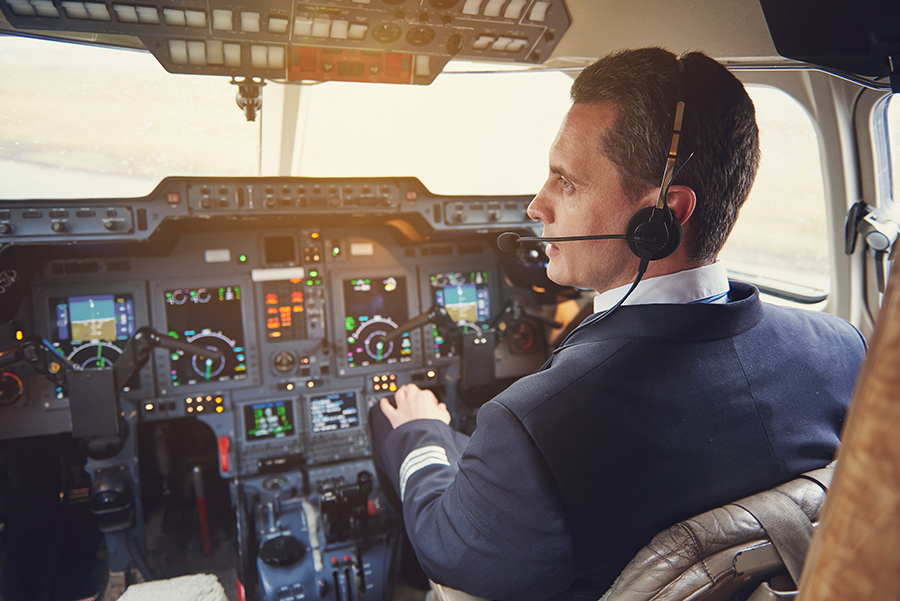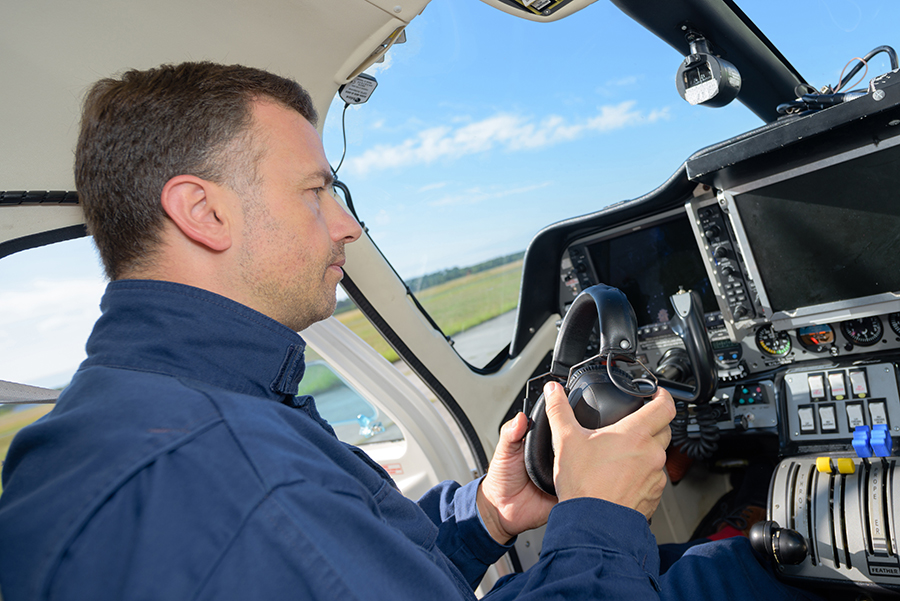-
Key Takeaways
-
What Are Airport Beacons?
-
What Are Airport Beacons Used For?
- Airport Beacon Colors
- Airport Beacon Flashing Rates
-
When Are Airport Beacons Used?
-
Airport Beacon Regulations
-
The History of Aviation Beacons
- The Airway Beacon System: 1920s – 1930s
- The Demise of the Airway Beacon System: 1940s – 1950s
-
The Future of Airport Beacons
- Increased Use of LED Technology
- Adoption of Remote Monitoring and Control
-
Common Issues With Airport Beacons
- Limited Visibility and Weather Conditions
- Misidentifying Beacon Colors
- Beacon Malfunctions
- Light Pollution and Obstructions
- Beacon Interference from Other Light Sources
-
Conclusion
Among the sea of colored lights found at an airport, you’ll always see one higher and brighter than the rest.
That’s the airport beacon.
What are these airport beacons, what is their purpose, and (most importantly) how do you read them?
Get ready to dive into the world of airport beacons!
Key Takeaways
- Airport beacons help pilots locate airports during night or low visibility conditions.
- Beacon colors indicate the type of airport, like civilian or military.
- Flashing rates and beacon operation are regulated by the FAA for safety.
- Modern upgrades include energy-efficient LED lights and potential remote monitoring systems.
What Are Airport Beacons?
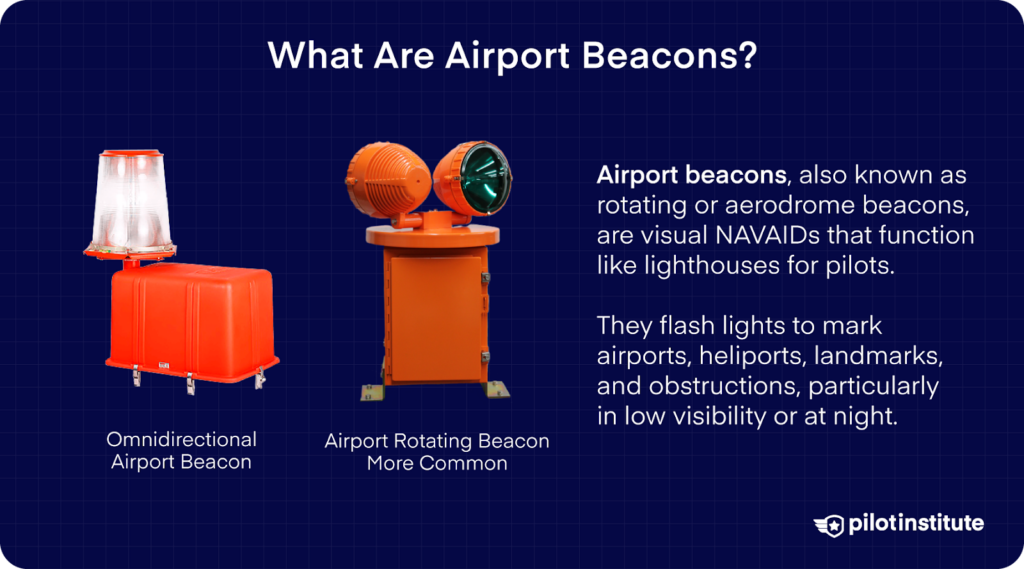
Airport beacons (also known as “airport rotating beacons” or “aerodrome beacons”) are like lighthouses for pilots.
Their primary purpose is to flash bright lights and mark the location of an airport at night or in low visibility.
You’ll usually find airport beacons mounted on tall structures (like control towers) so that they’re visible above other airport buildings.
Airport beacons are most effective when seen from one to ten degrees above the horizon but can also be spotted from other angles.
They use a bright omnidirectional flashing strobe or (more commonly) rotating lights that simulate flashes, like a lighthouse.
What Are Airport Beacons Used For?
Airport beacons not only provide a reference for where the airport is, but they can also provide information about the type of airport.
In the US, the Federal Aviation Administration (FAA) has rules about airport beacons, including how fast they should flash and what colors they should use.
Airport Beacon Colors
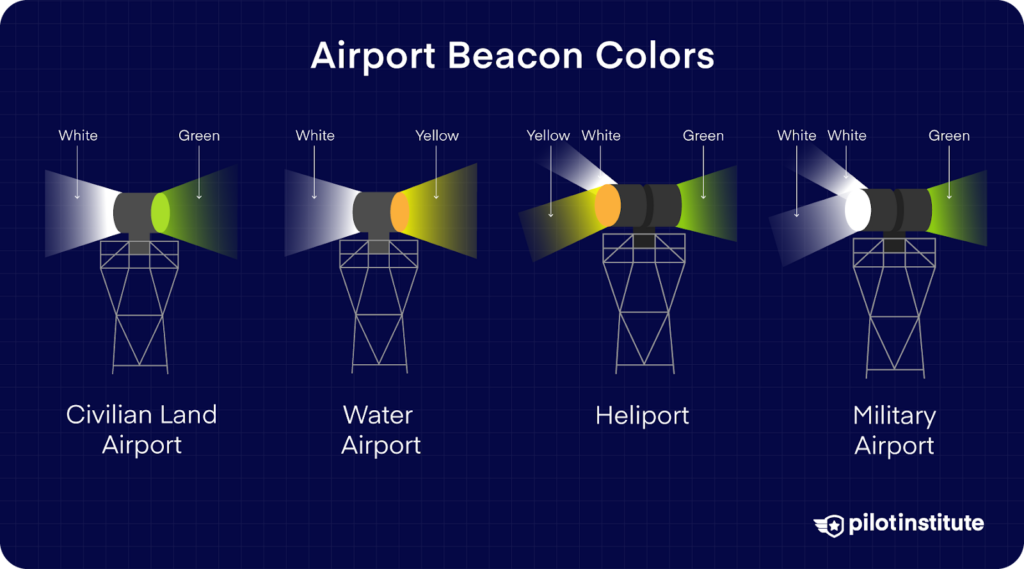
Airport beacons can provide information on the type of airport through the color of their lights:
- White and Green: Lighted Land Airport
- Single Green: Lighted Land Airport (used with a white-and-green beacon)
- White and Yellow: Lighted Water Airport
- Single Yellow: Lighted Water Airport (used with a white-and-yellow beacon)
- Green, Yellow, and White: Lighted Heliport
- White, White, Green: Military Airport (two quick white flashes between green flashes)
- White, Green, Amber: Hospital or Emergency Services Heliport
Airport Beacon Flashing Rates
Airport beacon flashing rates vary between types of airports:
- 24 to 30 flashes per minute for airports, landmarks, and points on Federal airways.
- 30 to 45 flashes per minute for heliports.
When Are Airport Beacons Used?
In busy airspace (Class B, C, D, and E surface areas), airport beacons are often turned on during the day when ground visibility is less than 3 miles or the ceiling is less than 1,000 feet.
This isn’t a strict rule, but it’s especially common at airports where Air Traffic Control (ATC) staff can control the beacons.
Speaking of ATC, they can turn beacons on or off at some airports. However, many airports use photoelectric cells or timers to control their beacons, so ATC staff can’t always control them directly.
Photoelectric cells detect the amount of light around the airport. If it’s nighttime, the signals from the photoelectric cells will cause the airport beacon to turn on.
Airport Beacon Regulations
The FAA details its specification requirements for airport beacons in AC 150/5345-12F.
Most of the specifications describe where and how the beacons must be mounted.
A few of the notable specifications include:
- The tower and beacon must be painted with aviation gloss orange and white.
- The beacon should be inspected daily for functionality.
- The glass in the beacon must be inspected twice a month to ensure it is clear.
- The electrical components and connections must be inspected every year.
- The lamp should be replaced every 30,000 hours.
The History of Aviation Beacons

In the early days of aviation, pilots relied heavily on landmarks as essential navigation tools to find their way during daytime flights.
But as the aviation industry grew, it became essential to provide a means for safe navigation during nighttime hours, too.
The Airway Beacon System: 1920s – 1930s
Initial experiments used bonfires as light sources. It quickly became apparent that bright light sources could become valuable navigational tools at night.
In 1923, the US Post Office (flying mail) began experimenting with a series of rotating beacons, each placed about 10 miles apart, to create an airway route from Cheyenne, Wyoming, to Chicago, Illinois.
This experiment marked the birth of the Airway Beacon System.
Each beacon was mounted on a tall tower and had a powerful rotating light to make it visible to pilots flying at night. Some beacons were even equipped with an auxiliary light that projected a specific course code onto the ground, allowing pilots to identify their location along the route.
By 1933, the US Airway Beacon System consisted of more than 1,500 beacons spread across approximately 18,000 miles of airways, guiding pilots safely through the skies at night.
The Demise of the Airway Beacon System: 1940s – 1950s
With the introduction of advanced radio navigation aids like VOR (VHF Omnidirectional Range) and ILS (Instrument Landing System) in the 1940s and 1950s, the Airway Beacon System began to lose its importance. These new technologies allowed pilots to navigate with greater accuracy and safety, even in low visibility conditions.
As a result, the maintenance and operation of the airway beacon system became less and less cost-effective, and the beacons were gradually decommissioned.
While the Airway Beacon System has largely become a thing of the past, airport beacons are still an essential part of aviation safety today.
The Future of Airport Beacons
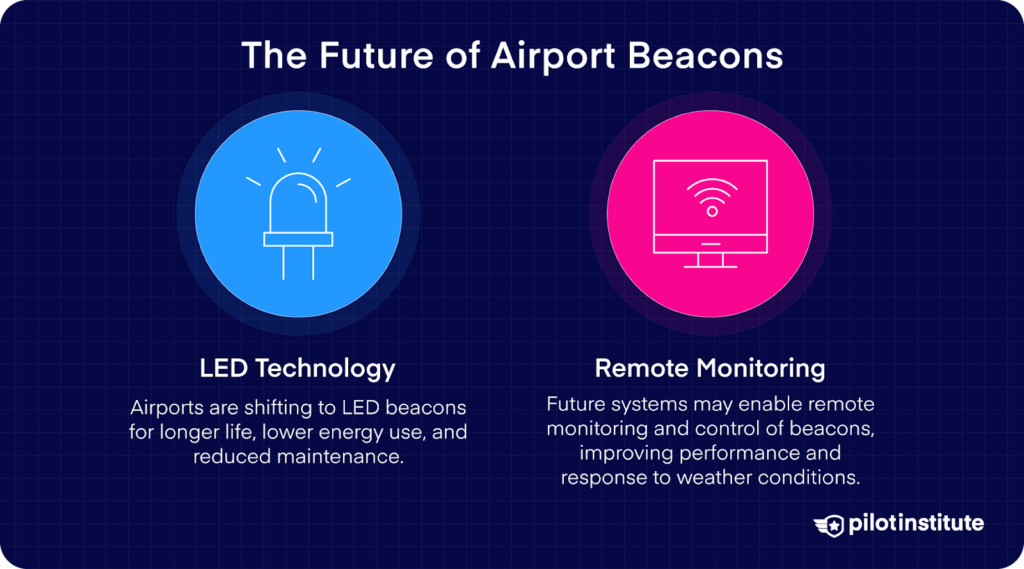
By now, you’re probably aware of the historical significance of airport beacons and their role in the evolution of aviation navigation. But what about their future?
Increased Use of LED Technology
One notable trend in airport beacon technology is the shift from traditional incandescent lights to energy-efficient LED lights. LEDs offer numerous advantages, such as longer life, lower power consumption, and reduced maintenance costs.
We can expect to see more airports transitioning to LED-based beacons in the coming years, making them more reliable and environmentally friendly.
Adoption of Remote Monitoring and Control
Another potential development in the future of airport beacons is the adoption of remote monitoring and control systems.
These systems would allow airport personnel to monitor the beacon’s performance from a central location, ensuring that the lights are functioning correctly and promptly addressing any issues.
Remote control capabilities could also enable the adjustment of beacon intensity or color patterns in response to changing weather conditions or other factors, providing better guidance to pilots.
Common Issues With Airport Beacons
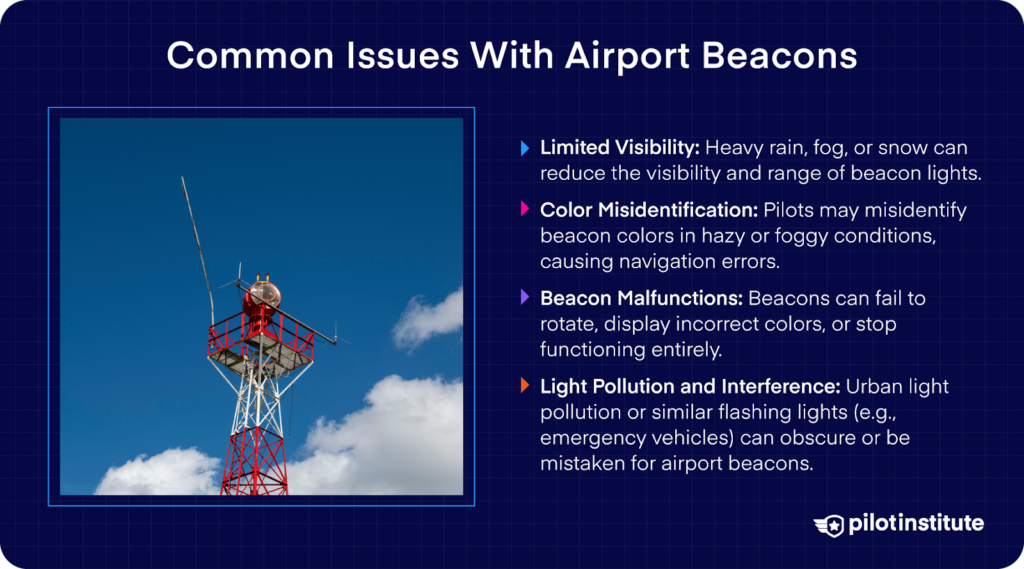
Like any piece of technology, airport beacons have their weak points.
Most issues regarding airport beacons are related to misidentification. Always cross-check airport beacon lights with other navigational information from charts, GPS, or VORs.
Limited Visibility and Weather Conditions
One of the most significant issues when using airport beacons is their effectiveness during low visibility situations, such as heavy rain, fog, or snow. While these lights are designed to be visible from a distance, adverse weather conditions can limit their range and effectiveness.
Misidentifying Beacon Colors
Different types of airports have distinct beacon color patterns. Pilots can sometimes misidentify these colors, especially when viewing them from a distance or through a hazy or foggy atmosphere. This can lead to confusion and potential navigation errors.
Beacon Malfunctions
Although rare, airport beacons can malfunction or experience technical issues. A beacon may fail to rotate, emit incorrect colors, or stop working altogether.
If you encounter a malfunctioning beacon, notify ATC or airport personnel as soon as possible to ensure they’re aware of the issue.
Light Pollution and Obstructions
In urban or densely populated areas, light pollution from nearby buildings, streetlights, and other sources can make it difficult to spot an airport beacon. Additionally, natural or artificial obstructions, such as hills or tall structures, can block the line of sight to a beacon.
Beacon Interference from Other Light Sources
In some cases, pilots may mistake other rotating or flashing lights for airport beacons. For example, rotating lights on emergency vehicles, communication towers, or construction sites can be confused with airport beacons, leading to navigation errors.
Conclusion
Airport beacons are important for helping pilots locate airports and aerodromes at night or in low visibility. They follow specific rules for flashing rates and colors depending on the type of airport or heliport.
Despite the incredible achievements and advancements in aviation technology, airport beacon lights are here to stay.
The reliable and straightforward bright light was a crucial navigational tool for early aviation pioneers and will continue to be a part of the airport skyline for decades.
Now we just need to teach future robot pilots how to read them.


